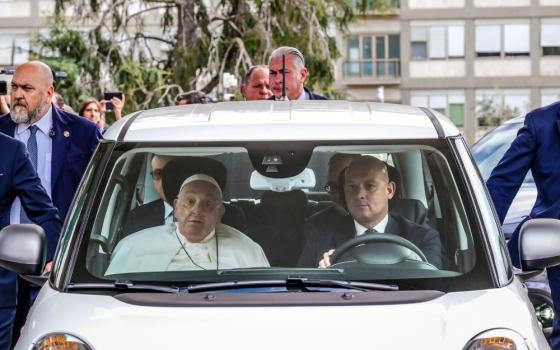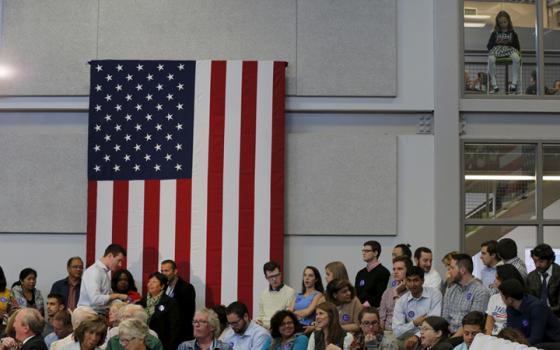
Excellent canon lawyers who are also excellent theologians are rare. Jesuit Fr. Ladislas Orsy, Hungarian-born but based in the United States, is one of them. His new book, Receiving the Council: Theological and Canonical Insights and Debates, is a distillation of his mature thought, composed of revised texts of previously published presentations, lectures and articles.
From first to last it breathes hope, faith and charity, and a model of how these should be approached. But it also contains dynamite.
In the discussion with Cardinal Joseph Ratzinger, now Pope Benedict XVI, which is the crown of this book, Orsy sets out his concern that the church is being moved in a disturbing direction, one that could take a long time to reverse.
The work of a canon lawyer, he says, is like that of the architect of a cathedral: to implement a vision, to give it a structural shape. Those in charge can, of course, botch the job. Orsy’s misgivings are plain.
Throughout the Second Vatican Council (1962-65), Orsy, teaching at the Gregorian University in Rome, marveled as the world’s Catholic bishops got to work. The council was the “awakening” of the “entire people of God,” he writes.
Exactly the same metaphor was used at the time by then-Fr. Ratzinger, who was at Vatican II as the expert adviser to Cardinal Josef Frings, archbishop of Cologne, Germany. In an overview of the council’s work, published a year after it ended, Ratzinger hailed “the awakening of the church” as “the true event” of Vatican II. But as is shown by the dialogue between him and Orsy, the two men came eventually to very different conclusions about the implications.
 RECEIVING THE COUNCIL: THEOLOGICAL AND CANONICAL INSIGHTS AND DEBATES RECEIVING THE COUNCIL: THEOLOGICAL AND CANONICAL INSIGHTS AND DEBATESBy Ladislas Orsy Published by Liturgical Press, $19.95 |
What makes Orsy’s approach so cogent is its grounding in what canon law actually says. Take the status of the laity, for example. Vatican II spoke of the whole “people of God” as a communion, a key concept for Orsy, before it spoke of the pope and bishops as a communion within the communion. Certainly, as Orsy acknowledges, the lay faithful now have a greater place in the internal life of the church than they did before. “They work in chanceries, ecclesiastical courts, parish councils and other ministries.” Here they have an opportunity in particular to apply the virtue of prudence, which is not guaranteed to the ordained.
Yet canon law separates the laity out again, excluding them from decision-making. Only the hierarchy has the power of governance. Laypeople can cooperate with this power but cannot share in it. The 1983 Code of Canon Law promulgated by Pope John Paul II restores the negative definition of the laity as those who are not clerics. The code calls them “the other members of the Christian faithful.”
Orsy is among those who are alarmed that a previous tradition in the church finds no echo in the new code. In the first millennium, lay men and women summoned ecumenical councils; most participants at the Council of Florence (1438-45) on the reunion of East and West were not ordained; abbesses for centuries had a power of jurisdiction. Looking beneath the surface, Orsy warns: “If the present situation becomes a norm for the future, the church will be more clerical than it ever was.”
He sees “turbulence” in the church today, resulting from the collision of two currents. One tends toward a new church order based on communion; the other seeks to restore an absolute monarchy, and at present is dominant.
The center’s gain is the bishops’ loss. One of Vatican II’s greatest advances was its doctrine that the college of bishops, with and under the pope (and so, not under the pope and Roman curia), governs the church. The council voted in favor by a huge majority but this was achieved by wording that could mean different things to different people. An Orsy footnote (throughout this book the small print is an invaluable resource) contends that today the Holy See’s reductive interpretation of the doctrine of collegiality brings it very close to that of the minority defeated at Vatican II.
Canon law proves just how far the competencies of the bishops’ conferences have been cut back. Vatican II put these conferences on a par with synods, in line with the structure of the early church where regional synods met regularly and took deliberative decisions. Accordingly, the council entrusted the conferences with oversight of the liturgical reforms. Later, the American bishops showed what they could do with their teaching documents on nuclear deterrence (1983) and economic justice (1986).
Orsy adds that the council’s recovery of a synodal perspective opened up a promising line of ecumenical reconciliation with the churches of the East and, at a greater distance, with the churches that issued from the Reformation. For the Eastern Orthodox have preserved synods side by side with primacy as the backbone of church government, and in an address in 2008 the ecumenical patriarch, Bartholomew, indicated that a recovery of that balance was a prerequisite for reunion with the West.
But Rome was to claw back the powers over the liturgy given to the conferences by the council, through the device of a necessary recognitio, or approval. In 1998 an apostolic letter of Pope John Paul II, Apostolos Suos, left the conferences without any voice of their own by right. “Effective” collegiality does not exist except when the bishops are together with the pope in an ecumenical council, or when, in gatherings or dispersed, they all intend and do the same thing. If even one bishop disagrees with the consensus of his colleagues, they can say nothing without the Holy See’s agreement. The conferences are mere associations of individual bishops.
Orsy argues this is to reduce bishops’ conferences to virtually the same legal status as the congregations of the Roman curia -- though the latter, unlike the former, “are entirely of human creation.” Legally, both curial departments and episcopal conferences are “administrative organs created by the authority of the pope,” and depend on the pope for such collective power as he grants them.
Meanwhile, the Rome Synod of Bishops, which many at Vatican II hoped would be a sort of continuing miniature council, “has become a mere consultative body to the pope (and the Roman curia).”
Orsy’s treatment is throughout sober, precise, responsible and hopeful, but always sharp. The truth is unmistakable, he says: “The function of the episcopate has been taken over to a great extent by the primacy.” Unity wins out over diversity. The church’s voice becomes too much a single blast on the trumpet, not enough the blended music of an orchestra. Loyalty and obedience are what is prized in a bishop, Orsy notes; creativity is suspect.
He keeps the choicest wine, the debate with Ratzinger, as cardinal prefect of the Vatican’s Congregation for the Doctrine of the Faith, published here in English for the first time, until last.
Ratzinger had strongly disagreed with some observations touching his congregation’s work that Orsy had presented in the Jesuit monthly Stimmen der Zeit of Munich, Germany. He sent a rebuttal. Orsy, who is not a Jesuit for nothing, noted that the cardinal had written in his own person, not using the letterhead of his congregation, and took the opportunity to draw him into a dialogue as a theologian.
Orsy’s charge is that the scope of the doctrine of infallibility, previously carefully restricted, has in effect been hugely extended by recent documents of the Holy See. Neither at Vatican I nor at Vatican II did the bishops conceive of any such enlargement. His concern is with Pope John Paul II’s 1988 apostolic letter Ad Tuendam Fidem “(To Guard the Faith”), the attendant doctrinal congregation commentary signed by Ratzinger, and the expanded profession of faith and the oath of fidelity that, since 1989, all officeholders are expected to take. These initiatives establish, Orsy contends, a new category of “definitive” teaching that is proclaimed as “irreformable” and attended by sanctions enshrined in canons inserted into the Code of Canon Law.
These developments seem to him to open up “a new and vast field for infallible teaching.” For what is the difference between infallible and “definitive”? Only the mode of promulgation, he thinks. “In the case of an infallible definition the pope must speak solemnly ex cathedra. ... In the case of a definitive teaching it is enough for him to indicate that his statement is intended to be definitive: No more is required.”
The argument between him and Ratzinger is technical, but clear. It cannot be said that the prefect of the doctrinal congregation gives any ground. The “Panzer Cardinal” is in evidence. But Ratzinger’s approach to his interlocutor does soften a touch as the exchanges continue. To begin with, Ratzinger accuses Orsy of “rather grave errors.” By the end, he is regretting that the Jesuit’s positions “are for me largely incomprehensible.”
It is a disturbing and illuminating discussion. Here and elsewhere in his book, Orsy sets out his concern that practical provisions in laws and ordinances of the Holy See are at work “in a subtle but forceful way, shaping the church of the future.”
He aims to illuminate this latest canonical architecture, and to plead for its review. He urges that the legal barrier to laity participating in decision-making should be revoked, so that new balances can be achieved that give proper recognition to the part played by the lay faithful in establishing the belief of the church. He thinks that “the universal law should acknowledge the fundamental right and duty of bishops ... to assemble for pastoral purposes,” and that “the crippling rule of unanimity for doctrinal proclamation should be removed.” One chapter tellingly compares the 1997 rules for the examination of doctrines with the vastly superior secular procedures. He calls for an organism to be set up to oversee the working of the code, so as to correct a “grave omission.”
When it comes to Ad Tuendam Fidem, he stresses that the apostolic letter is authentic papal teaching that demands obedient respect. His own loyal fidelity to church doctrine is evident on every page. But he points out that Vatican II leaves no doubt that pope and bishops together in an ecumenical council can “abandon, supersede or modify earlier papal teachings which were not ex cathedra definitions.” As regards the commentary of the Congregation for the Doctrine of the Faith, he suggests that perhaps its status can be compared to that of the drafts put before the bishops by the curia at the start of Vatican II. And we all know what happened to those drafts: They were voted down.
Orsy is aware that canon law is not in high favor among many in the church today. He recalls insisting to a French bishop, later a cardinal, during Vatican II that the reception of the council would largely depend on the new Code of Canon Law. The bishop’s reply: “I couldn’t care less about canon law.” Orsy think this inattention a mistake, one that Opus Dei for its part did not make. Opus Dei participated very little in the new secretariats created to carry forward the most reformist aspects of Vatican II, but from the start played an active role in the revision of the code.
Canon lawyers have only themselves to blame, Orsy thinks, if people tend to spurn their discipline. He recalls in another footnote being startled when he heard the dean of the canon law faculty at the Gregorian tell incoming students in 1954 that they must forget any idea of the scriptures or the fathers and doctors of the church being authorities. “In canon law,” said the dean, “they are not authorities.”
No need to go further, in Orsy’s opinion, to explain why many Catholics have a fixed aversion to canon law. This is not how to do it, Orsy thinks. The canon lawyer needs to make a bridge between letter and spirit by theological imagination. This book is a shining example of the best practice.
[John Wilkins is a former editor of The Tablet, the British Catholic weekly newspaper.]



